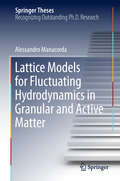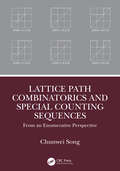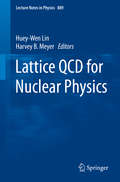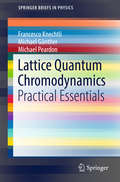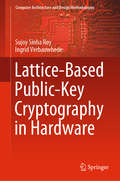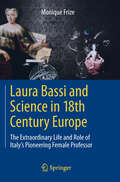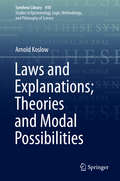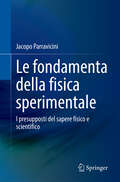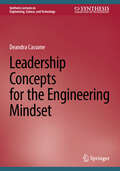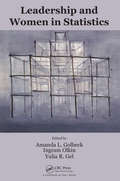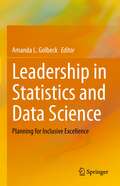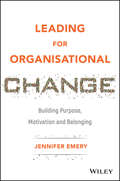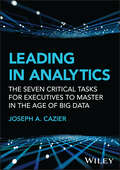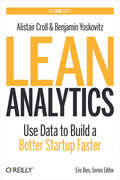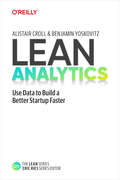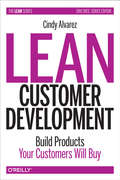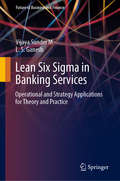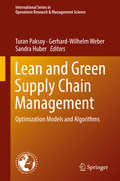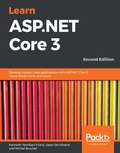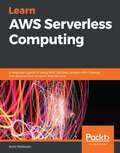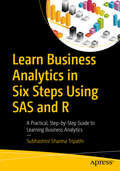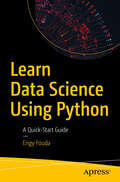- Table View
- List View
Lattice Models for Fluctuating Hydrodynamics in Granular and Active Matter (Springer Theses)
by Alessandro ManacordaThis book investigates the common nature of granular and active systems, which is rooted in their intrinsic out-of-equilibrium behavior, with the aim of finding minimal models able to reproduce and predict the complex collective behavior observed in experiments and simulations. Granular and active matter are among the most studied systems in out-of-equilibrium statistical physics. The book guides readers through the derivation of a fluctuating hydrodynamic description of granular and active matter by means of controlled and transparent mathematical assumptions made on a lattice model. It also shows how a macroscopic description can be provided from microscopic requirements, leading to the prediction of collective states such as cooling, swarming, clustering and the transitions among them. The analytical and numerical results shed new light on the physical connection between the local, microscopic properties of few particles and the macroscopic collective motion of the whole system.
Lattice Path Combinatorics and Special Counting Sequences: From an Enumerative Perspective
by Chunwei SongThis book endeavors to deepen our understanding of lattice path combinatorics, explore key types of special sequences, elucidate their interconnections, and concurrently champion the author's interpretation of the “combinatorial spirit”.The author intends to give an up-to-date introduction to the theory of lattice path combinatorics, its relation to those special counting sequences important in modern combinatorial studies, such as the Catalan, Schröder, Motzkin, Delannoy numbers, and their generalized versions. Brief discussions of applications of lattice path combinatorics to symmetric functions and connections to the theory of tableaux are also included. Meanwhile, the author also presents an interpretation of the "combinatorial spirit" (i.e., "counting without counting", bijective proofs, and understanding combinatorics from combinatorial structures internally, and more), hoping to shape the development of contemporary combinatorics.Lattice Path Combinatorics and Special Counting Sequences: From an Enumerative Perspective will appeal to graduate students and advanced undergraduates studying combinatorics, discrete mathematics, or computer science.
Lattice QCD for Nuclear Physics
by Huey-Wen Lin Harvey B. MeyerWith ever increasing computational resources and improvements in algorithms, new opportunities are emerging for lattice gauge theory to address key questions in strongly interacting systems, such as nuclear matter. Calculations today use dynamical gauge-field ensembles with degenerate light up/down quarks and the strange quark and it is possible now to consider including charm-quark degrees of freedom in the QCD vacuum. Pion masses and other sources of systematic error, such as finite-volume and discretization effects, are beginning to be quantified systematically. Altogether, an era of precision calculation has begun and many new observables will be calculated at the new computational facilities. The aim of this set of lectures is to provide graduate students with a grounding in the application of lattice gauge theory methods to strongly interacting systems and in particular to nuclear physics. A wide variety of topics are covered, including continuum field theory, lattice discretizations, hadron spectroscopy and structure, many-body systems, together with more topical lectures in nuclear physics aimed a providing a broad phenomenological background. Exercises to encourage hands-on experience with parallel computing and data analysis are included.
Lattice Quantum Chromodynamics
by Michael Günther Francesco Knechtli Michael PeardonThis book provides an overview of the techniques central to lattice quantum chromodynamics, including modern developments. The book has four chapters. The first chapter explains the formulation of quarks and gluons on a Euclidean lattice. The second chapter introduces Monte Carlo methods and details the numerical algorithms to simulate lattice gauge fields. Chapter three explains the mathematical and numerical techniques needed to study quark fields and the computation of quark propagators. The fourth chapter is devoted to the physical observables constructed from lattice fields and explains how to measure them in simulations. The book is aimed at enabling graduate students who are new to the field to carry out explicitly the first steps and prepare them for research in lattice QCD.
Lattice Sums Then and Now
by J. M. Borwein M. L. Glasser R. C. Mcphedran J. G. Wan I J. ZuckerThe study of lattice sums began when early investigators wanted to go from mechanical properties of crystals to the properties of the atoms and ions from which they were built (the literature of Madelung's constant). A parallel literature was built around the optical properties of regular lattices of atoms (initiated by Lord Rayleigh, Lorentz and Lorenz). For over a century many famous scientists and mathematicians have delved into the properties of lattices, sometimes unwittingly duplicating the work of their predecessors. Here, at last, is a comprehensive overview of the substantial body of knowledge that exists on lattice sums and their applications. The authors also provide commentaries on open questions, and explain modern techniques which simplify the task of finding new results in this fascinating and ongoing field. Lattice sums in one, two, three, four and higher dimensions are covered.
Lattice-Based Public-Key Cryptography in Hardware (Computer Architecture and Design Methodologies)
by Ingrid Verbauwhede Sujoy Sinha RoyThis book describes the efficient implementation of public-key cryptography (PKC) to address the security challenges of massive amounts of information generated by the vast network of connected devices, ranging from tiny Radio Frequency Identification (RFID) tags to powerful desktop computers. It investigates implementation aspects of post quantum PKC and homomorphic encryption schemes whose security is based on the hardness of the ring-learning with error (LWE) problem. The work includes designing an FPGA-based accelerator to speed up computation on encrypted data in the cloud computer. It also proposes a more practical scheme that uses a special module called recryption box to assist homomorphic function evaluation, roughly 20 times faster than the implementation without this module.
Laura Bassi and Science in 18th Century Europe: The Extraordinary Life and Role of Italy's Pioneering Female Professor
by Monique FrizeThis book presents the extraordinary story of a Bolognese woman of the settecento. Laura Maria Caterina Bassi (1711-1778) defended 49 Theses at the University of Bologna on April 17, 1732 and was awarded a doctoral degree on May 12 of the same year. Three weeks before her defense, she was made a member of the Academy of Sciences in Bologna. On June 27 she defended 12 additional Theses. Several of the 61 Theses were on physics and other science topics. Laura was drawn by the philosophy of Newton at a time when most scientists in Europe were still focused on Descartes and Galen. This last set of Theses was to encourage the University of Bologna to provide a lectureship to Laura, which they did on October 29, 1732. Although quite famous in her day, Laura Bassi is unfortunately not remembered much today. This book presents Bassi within the context of the century when she lived and worked, an era where no women could attend university anywhere in the world, and even less become a professor or a member of an academy. Laura was appointed to the Chair of experimental physics in 1776 until her death. Her story is an amazing one. Laura was a mother, a wife and a good scientist for over 30 years. She made the transition from the old science to the new very early on in her career. Her work was centered on real problems that the City of Bologna needed to solve. It was an exciting time of discovery and she was at the edge of it all the way.
Laws and Explanations; Theories and Modal Possibilities (Synthese Library #410)
by Arnold KoslowThe book has two parts: In the first, after a review of some seminal classical accounts of laws and explanations, a new account is proposed for distinguishing between laws and accidental generalizations (LAG). Among the new consequences of this proposal it is proved that any explanation of a contingent generalization shows that the generalization is not accidental. The second part involves physical theories, their modality, and their explanatory power. In particular, it is shown that (1) Each theory has a theoretical implication structure associated with it, such that there are new physical modal operators on these structures and also special modal entities that are in these structures. A special subset of the physical modals, the nomic modals are associated with the laws of theories. (2) The familiar idea that theories always explain laws by deduction of them has to be seriously modified in light of the fact that there are a host of physical theories (including for example, Newtonian Classical mechanics, Hamiltonian, and Lagrangian theory, and probability theory) that we believe are schematic (they do not have any truth value). Nevertheless, we think that there is a kind of non-deductive explanation and generality that they achieve by subsumtion under a schema.
Lazare and Sadi Carnot
by Raffaele Pisano Charles C. GillispieLazare Carnot was the unique example in the history of science of someone who inadvertently owed the scientific recognition he eventually achieved to earlier political prominence. He and his son Sadi produced work that derived from their training as engineering and went largely unnoticed by physicists for a generation or more, even though their respective work introduced concepts that proved fundamental when taken up later by other hands. There was, moreover, a filial as well as substantive relation between the work of father and son. Sadi applied to the functioning of heat engines the analysis that his father had developed in his study of the operation of ordinary machines. Specifically, Sadi's idea of a reversible process originated in the use his father made of geometric motions in the analysis of machines in general. This unique book shows how the two Carnots influenced each other in their work in the fields of mechanics and thermodynamics, and how future generations of scientists have further benefited from their work.
Le fondamenta della fisica sperimentale: I presupposti del sapere fisico e scientifico
by Jacopo ParraviciniQuesto libro ha lo scopo di fornire un’ampia riflessione sui principi generali della fisica e gli elementi fondanti della conoscenza scientifica nella loro unitarietà. Sfruttando largamente il pensiero di molti tra i più grandi scienziati, esso offre una chiara comprensione dei fondamenti della fisica e del suo metodo sperimentale, ponendo in risalto le correlazioni tra i principali eterogenei elementi che vi stanno alla base. Si ricorda come le scienze sperimentali non siano statiche ma, al contrario, soggette a continui studi e ripensamenti. Nell'affrontare la mancanza di lezioni o trattazioni sistematiche sulla natura del metodo scientifico nei tradizionali corsi universitari tecnico-scientifici, l'autore si addentra così nello studio di ciò che sta alla base della scienza in generale, e della fisica in particolare. Sono trattati temi quali la relazione tra fenomeni naturali e il linguaggio matematico, mettendo in risalto i principali snodi dello sviluppo concettuale nella scienza. Inoltre l’autore discute l’importanza della “pratica scientifica” sottolineandone il ruolo nell’avanzamento della conoscenza scientifica, e il modo con cui essa contribuisce alla fisica nel suo complesso. Il libro è suddiviso in tre parti, ciascuna delle quali copre differenti aspetti della fisica e dei suoi fondamenti: la prima parte riguarda le radici fenomenologiche e gli strumenti basilari della disciplina; la seconda si concentra sulla struttura della conoscenza scientifica; la terza tratta i metodi pratici dell’indagine scientifica. Il libro rimane accessibile per qualsiasi studente di discipline tecnico-scientifiche, poiché un non fisico sarà agevolmente in grado di trovare facilmente in libri di testo di natura introduttiva spiegazioni di quei concetti fondamentali dati per assodati.
Leadership Concepts for the Engineering Mindset (Synthesis Lectures on Engineering, Science, and Technology)
by Deandra CassoneThe book is intended to focus the engineer or technically minded individual on key aspects of their organization and how they can leverage their position to make a positive impact. The author explains why it is critical that the technically minded individual is aware of their corporate environment and how they and their organization fit within the organizational structure. Technical knowledge is just one component of success for engineers. The book provides readers with the tools to understand where they fit in with their organizations and what they can do to support corporate objectives. This book will address topics including gaining a big picture of an organization, defining what a specific organization does, understanding goals and objectives to align management strategies, budgeting, role in the supply chain, engineering career paths, and the importance of innovation.
Leadership and Women in Statistics
by Amanda L. Golbeck Ingram Olkin Yulia R. GelLearn How to Infuse Leadership into Your Passion for Scientific Research Leadership and Women in Statistics explores the role of statisticians as leaders, with particular attention to women statisticians as leaders. By paying special attention to women's issues, this book provides a clear vision for the future of women as leaders in scientific and
Leadership in Statistics and Data Science: Planning for Inclusive Excellence
by Amanda L. GolbeckThis edited collection brings together voices of the strongest thought leaders on diversity, equity and inclusion in the field of statistics and data science, with the goal of encouraging and steering the profession into the regular practice of inclusive and humanistic leadership. It provides futuristic ideas for promoting opportunities for equitable leadership, as well as tested approaches that have already been found to make a difference. It speaks to the challenges and opportunities of leading successful research collaborations and making strong connections within research teams. Curated with a vision that leadership takes a myriad of forms, and that diversity has many dimensions, this volume examines the nuances of leadership within a workplace environment and promotes storytelling and other competencies as critical elements of effective leadership. It makes the case for inclusive and humanistic leadership in statistics and data science, where there often remains a dearth of women and members of certain racial communities among the employees. Titled and non-titled leaders will benefit from the planning, evaluation, and structural tools offered within to contribute inclusive excellence in workplace climate, environment, and culture.
Leading for Organisational Change: Building Purpose, Motivation and Belonging
by Jennifer EmeryHarness the seven key elements of successful organisational change Leading for Organisational Change is an intelligent and practical guide to the human side of merger integration and other organisational change. Building a clear sense of common purpose and then reinforcing it through storytelling can underpin the success of an integration or significant change programme. Pulling together the best thinking from neuroscience, psychology and business, and her rich personal experience in twenty years of leading change projects in professional services organisations and other people-centred businesses, author Jennifer Emery presents a framework for change rooted in seven key themes that help organisations establish their BECAUSE: belonging, evolution, confidence, agility, understanding, simplicity and energy. Exploring the role each theme plays in the context of change, this insightful and warm book shares real-world examples and provides advice on building purpose and culture and strengthening motivation through listening, empowering and collaborating. Clear understanding of purpose, powerful communication techniques and carefully planned implementation strategies assist in navigating an often stressful and uncertain period of change, and can even enable organisations to thrive throughout this period. This book encourages you to apply important lessons to your own context, allowing you to: Focus on the human, cultural and practical elements of organisational change Apply central concepts of communication and motivation to a wide array of situations in your personal and business life Understand perspectives on change from a broad range of professional sectors Build and strengthen communication skills to promote a sense of shared purpose Leading for Organisational Change offers a warm and intelligent perspective on the personal and inter-personal factors that contribute to successful integration. An invaluable resource for professional services and people-focused organisations, this book provides advice that can cross sectors and lend insight to any major change programme.
Leading in Analytics: The Seven Critical Tasks for Executives to Master in the Age of Big Data (Wiley and SAS Business Series)
by Joseph A. CazierA step-by-step guide for business leaders who need to manage successful big data projects Leading in Analytics: The Critical Tasks for Executives to Master in the Age of Big Data takes you through the entire process of guiding an analytics initiative from inception to execution. You’ll learn which aspects of the project to pay attention to, the right questions to ask, and how to keep the project team focused on its mission to produce relevant and valuable project. As an executive, you can’t control every aspect of the process. But if you focus on high-impact factors that you can control, you can ensure an effective outcome. This book describes those factors and offers practical insight on how to get them right. Drawn from best-practice research in the field of analytics, the Manageable Tasks described in this book are specific to the goal of implementing big data tools at an enterprise level. A dream team of analytics and business experts have contributed their knowledge to show you how to choose the right business problem to address, put together the right team, gather the right data, select the right tools, and execute your strategic plan to produce an actionable result. Become an analytics-savvy executive with this valuable book. Ensure the success of analytics initiatives, maximize ROI, and draw value from big data Learn to define success and failure in analytics and big data projects Set your organization up for analytics success by identifying problems that have big data solutions Bring together the people, the tools, and the strategies that are right for the jobBy learning to pay attention to critical tasks in every analytics project, non-technical executives and strategic planners can guide their organizations to measurable results.
Lean Analytics: Use Data to Build a Better Startup Faster
by Alistair Croll Benjamin YoskovitzWhether you're a startup founder trying to disrupt an industry or an intrapreneur trying to provoke change from within, your biggest challenge is creating a product people actually want. Lean Analytics steers you in the right direction. This book shows you how to validate your initial idea, find the right customers, decide what to build, how to monetize your business, and how to spread the word. Packed with more than thirty case studies and insights from over a hundred business experts, Lean Analytics provides you with hard-won, real-world information no entrepreneur can afford to go without. Understand Lean Startup, analytics fundamentals, and the data-driven mindset Look at six sample business models and how they map to new ventures of all sizes Find the One Metric That Matters to you Learn how to draw a line in the sand, so you'll know it's time to move forward Apply Lean Analytics principles to large enterprises and established products
Lean Analytics: Use Data to Build a Better Startup Faster
by Alistair Croll Benjamin YoskovitzWhether you're a startup founder trying to disrupt an industry or an entrepreneur trying to provoke change from within, your biggest challenge is creating a product people actually want. Lean Analytics steers you in the right direction.This book shows you how to validate your initial idea, find the right customers, decide what to build, how to monetize your business, and how to spread the word. Packed with more than thirty case studies and insights from over a hundred business experts, Lean Analytics provides you with hard-won, real-world information no entrepreneur can afford to go without.Understand Lean Startup, analytics fundamentals, and the data-driven mindsetLook at six sample business models and how they map to new ventures of all sizesFind the One Metric That Matters to youLearn how to draw a line in the sand, so you'll know it's time to move forwardApply Lean Analytics principles to large enterprises and established products
Lean Customer Development: Building Products Your Customers Will Buy
by Cindy AlvarezHow do you develop products that people will actually use and buy? This practical guide shows you how to validate product and company ideas through customer development research—before you waste months and millions on a product or service that no one needs or wants.With a combination of open-ended interviewing and fast and flexible research techniques, you’ll learn how your prospective customers behave, the problems they need to solve, and what frustrates and delights them. These insights may shake your assumptions, but they’ll help you reach the "ah-ha!" moments that inspire truly great products.Validate or invalidate your hypothesis by talking to the right peopleLearn how to conduct successful customer interviews play-by-playDetect a customer’s behaviors, pain points, and constraintsTurn interview insights into Minimum Viable Products to validate what customers will use and buyAdapt customer development strategies for large companies, conservative industries, and existing products
Lean Six Sigma im Bankensektor: Operative und strategische Anwendungen für Theorie und Praxis
by Vijaya Sunder M L. S. GaneshDieses Buch untersucht eine Reihe möglicher Wege, Modelle sowie operativer und strategischer Ansätze für Lean Six Sigma (LSS), eine zeitgemäße Praxis der kontinuierlichen Verbesserung (CI) zur Erzielung eines qualitätsbasierten Wettbewerbsvorteils in Organisationen. Fallstudien von Lean-Six-Sigma-Projekten in Bankunternehmen helfen, die operativen Dimensionen von LSS zu veranschaulichen, während die hier vorgestellten fallspezifischen und fallübergreifenden Analysen den strategischen Wert von LSS demonstrieren. Die Falldaten, die zur Gewinnung der Erkenntnisse herangezogen wurden, stammen zwar aus dem Bankensektor, ermöglichen jedoch eine Verallgemeinerung über den Bank- und Finanzdienstleistungssektor hinaus.Das Buch vertritt die Auffassung, dass LSS nicht nur eine KI-Praxis ist, sondern eine übergeordnete organisatorische Fähigkeit, genauer gesagt eine dynamische Fähigkeit, die es Unternehmen ermöglicht, einen auf Qualität basierenden Wettbewerbsvorteil zu erzielen. Das Buch richtet sich an Praktiker und Forscher gleichermaßen und schafft ein Gleichgewicht zwischen Theorie und Praxis.Für Praktiker bietet es einen Leitfaden für den Einsatz von LSS zur Erzielung von Wettbewerbsvorteilen und für evidenzbasierte Praktiken im Qualitätsmanagement und der operativen Exzellenz. Für Wissenschaftler stellt es eine Fülle von Literatur vor und erweitert den Wissensschatz zum Qualitätsmanagement. Dementsprechend ist das Buch sowohl für Praktiker als auch für Forscher von unschätzbarem Wert, da es ersteren hilft, den Wert von LSS sowohl als operative als auch als strategische Ressource zu erschließen, und letzteren potenzielle Forschungsrichtungen und Anwendungen aufzeigt."Dieses Buch vermittelt ein tiefes Verständnis der Lean Six Sigma-Anwendungen. Es inspiriert, indem es die Prinzipien des Konzepts auf ungewöhnliche Bereiche von Betrieb und Management jenseits des üblichen Qualitäts- und Projektmanagements überträgt. Beim Lesen des Buches kam mir die großartige Idee, Lean Six Sigma auch in meinem digitalen Unternehmenanzuwenden. Am Ende des Buches hatte ich den Eindruck, dass die Möglichkeiten für den richtigen Einsatz von Lean Six Sigma grenzenlos sind, insbesondere wenn man es aus der Perspektive der dynamischen Fähigkeiten betrachtet. Die Leser dieses Buches werden sicherlich Einblicke in die Verbesserung ihrer Geschäftsprozesse sowohl in operativer als auch in strategischer Hinsicht erhalten. Obwohl sich das Buch auf den Bankensektor konzentriert, eignet es sich eigentlich für ein sehr breites Publikum. Es handelt sich um eine brillante Forschungsarbeit und ein Buch, das als Leitfaden für die Transformation durch das Prisma von Lean Six Sigma dienen wird."- Professorin. Dr. ZornitsaYordanova, Leitende Assistenzprofessorin für Innovationsmanagement, Universität für nationale und internationale Wirtschaft, Sofia, Bulgarien"Lean Six Sigma muss aus einer Systemperspektive heraus verstanden werden, undes besteht eine große Wissenslücke in diesem Bereich, wenn es darum geht, ganzheitliche Lösungen für Geschäftsprobleme zu finden. Dieses Buch ist ein sehr willkommenes Werk, das diese Forderung aufgreift. Es integriert die Ressourcen des Qualitätsmanagements und die Sichtweise der dynamischen Fähigkeiten in die Praxis. Der Bereich Banken und Finanzdienstleistungen wurde passend gewählt, da er für Sozialunternehmen am unmittelbarsten anwendbar ist. Jeder, der mit weniger Mitteln mehr Wirkung erzielen möchte, wird von der Lektüre dieses Buches profitieren.-Alex Abraham, Hauptgeschäftsführer, Lean Success Partners, Winnipeg, Manitoba, Kanada"Das Buch ist eine erfrischende Bereicherung für die Welt des Qualitätsmanagements, insbesondere im Kontext von Banken und Finanzdienstleistungen. Konzepte und Begriffe wie "Schnelligkeit von Lean & Robustheit von Six Sigma zur Lösung operativer Probleme" "Hybride Methodik" passen sehr gut zu dem, was wir heute in der Branche tun.Ein weiterer interessanter Aspekt des Buches ist die Anwendung des "Dynamic Capabilities"-Ansatze
Lean Six Sigma in Banking Services: Operational and Strategy Applications for Theory and Practice (Future of Business and Finance)
by Vijaya Sunder M L. S. GaneshThis book explores a range of prospective avenues, models, and operational and strategic approaches to Lean Six Sigma (LSS), a contemporary Continuous Improvement (CI) practice for achieving a quality-based competitive edge in organisations. Lean Six Sigma project case studies from banking organizations help to illustrate the operational dimensions of LSS, while the case-specific and cross-case analyses presented here demonstrate its strategic value. While the case data used to arrive at the findings come from the Banking firms, it allows generalizability beyond the Banking and Financial Services sector. The book contends that LSS is not merely a CI practice, but a higher-order organizational capability, more precisely a dynamic capability, that allows firms to gain a competitive edge based on quality. Addressing the interests of practitioners and researchers alike, the book strikes a balance between theory and practice. For practitioners, it offers guidance on using LSS to gain a competitive advantage, and on evidence-based practice in quality management and operational excellence. For researchers, it presents a wealth of literature and expands the body of knowledge on quality management. Accordingly, the book is of immense value to both practitioners and researchers, helping the former unlock the value of LSS as both an operational and strategic resource, and highlighting potential research directions and applications for the latter.“This book provides a deep understanding of Lean Six Sigma applications. It inspires by transferring the principles of the concept into uncommon areas of operations and management behind the usual quality and project management. While reading the book I got hit by a great idea of applying Lean Six Sigma in my digital business as well. My impression at the end of the book was that sky is the limit for the right employment of Lean Six Sigma, especially while viewing it from a dynamic capabilities’ lens. Readers of this book will surely receive insights for improving their business processes both operationally and strategically. Although the book is focused on banking, it is actually suitable for a really wide audience. This is a brilliant piece of research as a book that will serve as a guide for transformation by the prism of Lean Six Sigma.” - Professor. Dr. ZornitsaYordanova, Chief Assistant Professor of Innovation Management, University of National and World Economy, Sofia, Bulgaria “Lean Six Sigma needs to be understood from a systems perspective and there exists a huge knowledge gap in this area of finding holistic solutions to business problems. This book is a very welcome work that addresses this call. It integrates quality management resources and dynamic capabilities view towards practice. Banking and Financial Services was aptly chosen as it has the most direct applicability for social enterprises. Anyone interested in creating more impact with less will surely benefit from reading the book” -Alex Abraham, Chief Executive Officer, Lean Success Partners, Winnipeg, Manitoba, Canada “The book is a refreshing booster to the world of Quality Management especially in the context of Banking and Financial Services. Concepts and terms like “Rapidness of Lean & robustness of Six Sigma to solve operational problems” “Hybrid methodology” resonate very well with what we do in the industry today. Another interesting fact about the book is applying “Dynamic Capabilities approach” to Quality Management, that sets a fresh Quality Oven and ensures this book is definitely a good investment of authors’ intellect.Best part – Even if a reader is new to the world of Quality,this book will be appropriate and resonating. For Researchers and Practitioners, both being leaders orfresh entrants, this book stands out to be a must-read, as it demonstrates the success of the Lean Six Sigma methodology via case studies and practical applications.” -Udit Salvan, Di
Lean and Green Supply Chain Management: Optimization Models and Algorithms (International Series in Operations Research & Management Science #273)
by Gerhard-Wilhelm Weber Turan Paksoy Sandra HuberThis book presents the latest developments in optimization and optimal control models; exact, approximate and hybrid methods; and their applications in lean and green supply chains. It examines supply chain network design and modeling, closed loop supply chains, and lean, green, resilient and agile or responsive networks, and also discusses corporate social responsibility and occupational health and safety. It particularly focuses on supply chain management under uncertainty – employing stochastic or nonlinear modeling, simulation based studies and optimization – multi-criteria decision-making and applications of fuzzy set theory, and covers various aspects of supply chain management such as risk management, supplier selection or the design of automated warehouses. Lastly, using experimental applications and practical case studies, it shows the impact of lean and green applications on vehicle/fleet management and operations management.
Learn ASP.NET Core 3: Develop modern web applications with ASP.NET Core 3, Visual Studio 2019, and Azure, 2nd Edition
by Jason De Oliveira Michel Bruchet Kenneth Yamikani FukiziA beginner's guide to building fully functioning web applications from scratch using the latest features of ASP.NET Core 3 and C# 8 Key Features Get to grips with the new features and APIs in ASP.NET Core 3, EF Core 3, and Blazor Create web APIs that integrate your applications with other systems and services Learn to deploy your web applications in new environments such as the cloud and Docker containers Book Description ASP.NET Core is an open source framework from Microsoft that makes it easy to build highly efficient and dynamic cross-platform web applications. Updated for the latest features of ASP.NET Core 3, this second edition will equip you with the skills you need to build powerful web applications. The book starts with an introduction to ASP.NET Core and its features, giving you a complete understanding of the framework. You will also learn how to set up your development environment with Visual Studio 2019 and build a fully functioning application from scratch. You'll then understand core concepts for building web applications such as Model View Controller (MVC), dependency injection, and WebSockets. As you advance, you'll discover how to use Entity Framework Core 3 to automate all database-related activities for your application. You will then build and document secure web APIs using security best practices to protect your web applications from threats and vulnerabilities. Finally, you will learn how to use Azure DevOps as a CI/CD tool to deploy and monitor your applications using Microsoft Azure, Amazon Web Services (AWS), and Docker. By the end of this book, you'll have the skills you need to develop efficient and robust web applications in ASP.NET Core 3. What you will learn Delve into basic and advanced ASP.NET Core 3 concepts with the help of examples Build an MVC web application and use Entity Framework Core 3 to access data Add web APIs to your web applications using RPC, REST, and HATEOAS Create a fully automated continuous integration and continuous delivery (CI/CD) pipeline using Azure DevOps Use Azure, Amazon Web Services, and Docker to deploy and monitor your applications Secure your web application from common attacks such as Cross-Site Scripting and SQL injection Explore client-side development using C# Razor components Who this book is for This book is for developers who want to build modern web applications with ASP.NET Core. The book will also be helpful for anyone working in infrastructure engineering and operations to monitor and diagnose problems during the runtime of ASP.NET Core 3.0 web applications. Although no prior understanding of ASP.NET or .NET Core is required, basic C# programming knowledge is assumed.
Learn AWS Serverless Computing: A beginner's guide to using AWS Lambda, Amazon API Gateway, and services from Amazon Web Services
by Scott PattersonBuild, deploy, test, and run cloud-native serverless applications using AWS Lambda and other popular AWS services Key Features Learn how to write, run, and deploy serverless applications in Amazon Web Services Make the most of AWS Lambda functions to build scalable and cost-efficient systems Build and deploy serverless applications with Amazon API Gateway and AWS Lambda functions Book Description Serverless computing is a way to run your code without having to provision or manage servers. Amazon Web Services provides serverless services that you can use to build and deploy cloud-native applications. Starting with the basics of AWS Lambda, this book takes you through combining Lambda with other services from AWS, such as Amazon API Gateway, Amazon DynamoDB, and Amazon Step Functions. You'll learn how to write, run, and test Lambda functions using examples in Node.js, Java, Python, and C# before you move on to developing and deploying serverless APIs efficiently using the Serverless Framework. In the concluding chapters, you'll discover tips and best practices for leveraging Serverless Framework to increase your development productivity. By the end of this book, you'll have become well-versed in building, securing, and running serverless applications using Amazon API Gateway and AWS Lambda without having to manage any servers. What you will learn Understand the core concepts of serverless computing in AWS Create your own AWS Lambda functions and build serverless APIs using Amazon API Gateway Explore best practices for developing serverless applications at scale using Serverless Framework Discover the DevOps patterns in a modern CI/CD pipeline with AWS CodePipeline Build serverless data processing jobs to extract, transform, and load data Enforce resource tagging policies with continuous compliance and AWS Config Create chatbots with natural language understanding to perform automated tasks Who this book is for This AWS book is for cloud architects and developers who want to build and deploy serverless applications using AWS Lambda. A basic understanding of AWS is required to get the most out of this book.
Learn Business Analytics in Six Steps Using SAS and R
by Subhashini Sharma TripathiApply analytics to business problems using two very popular software tools, SAS and R. No matter your industry, this book will provide you with the knowledge and insights you and your business partners need to make better decisions faster. Learn Business Analytics in Six Steps Using SAS and R teaches you how to solve problems and execute projects through the "DCOVA and I" (Define, Collect, Organize, Visualize, Analyze, and Insights) process. You no longer need to choose between the two most popular software tools. This book puts the best of both worlds—SAS and R—at your fingertips to solve a myriad of problems, whether relating to data science, finance, web usage, product development, or any other business discipline.What You'll LearnUse the DCOVA and I process: Define, Collect, Organize, Visualize, Analyze and Insights. Harness both SAS and R, the star analytics technologies in the industry Use various tools to solve significant business challengesUnderstand how the tools relate to business analytics See seven case studies for hands-on practiceWho This Book Is ForThis book is for all IT professionals, especially data analysts, as well as anyone whoLikes to solve business problems and is good with logical thinking and numbers Wants to enter the analytics world and is looking for a structured book to reach that goalIs currently working on SAS , R, or any other analytics software and strives to use its full power
Learn Data Science Using Python: A Quick-Start Guide
by Engy FoudaHarness the capabilities of Python and gain the expertise need to master data science techniques. This step-by-step book guides you through using Python to achieve tasks related to data cleaning, statistics, and visualization. You’ll start by reviewing the foundational aspects of the data science process. This includes an extensive overview of research points and practical applications, such as the insightful analysis of presidential elections. The journey continues by navigating through installation procedures and providing valuable insights into Python, data types, typecasting, and essential libraries like Pandas and NumPy. You’ll then delve into the captivating world of data visualization. Concepts such as scatter plots, histograms, and bubble charts come alive through detailed discussions and practical code examples, unraveling the complexities of creating compelling visualizations for enhanced data understanding. Statistical analysis, linear models, and advanced data preprocessing techniques are also discussed before moving on to preparing data for analysis, including renaming variables, variable rearrangement, and conditional statements. Finally, you’ll be introduced to regression techniques, demystifying the intricacies of simple and multiple linear regression, as well as logistic regression. What You’ll Learn Understand installation procedures and valuable insights into Python, data types, typecasting Examine the fundamental statistical analysis required in most data science and analytics reports Clean the most common data set problems Use linear progression for data prediction Who This Book Is For Data Analysts, data scientists, Python programmers, and software developers new to data science.
